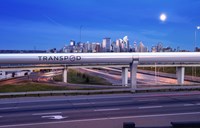
TransPod, the startup that is building the world’s leading hyperloop system to disrupt and redefine commercial transportation, today released the results of its Initial Order of Magnitude Analysis to build a TransPod ultra-high-speed line in Southwestern Ontario between the cities of Toronto and Windsor, with multiple stops in between. The study indicates that building a TransPod hyperloop system will cost half the projected cost of a high-speed rail (HSR) line along the same route, while offering faster and more efficient transportation for passengers and cargo, at more than four times the top speed of HSR.
The Government of Ontario recently announced an investment of $15 million for an environmental assessment of its plans for an HSR line along the same Toronto-Windsor corridor. Premier Kathleen Wynne introduced a study conducted by former federal minister David Collenette, to present one option for a way forward to tackle the growing challenges of urban mobility, environmental sustainability, and economic growth in the region.
“Southwestern Ontario accounts for 50 per cent of the province’s GDP, and developing high-speed transportation for the region will absolutely benefit and strengthen its economic growth and global competitiveness,” said Sebastien Gendron, co-founder and CEO, TransPod. “But we need to future-proof ourselves, and we can’t continue with outdated technology. Countries like China, Japan, and South Korea have already moved past high-speed rail and begun building much faster trains using magnetic levitation – the age of high-speed rail has come and gone, and the technology will soon be obsolete. We strongly urge the Government of Ontario to consider hyperloop feasibility, for its cost efficiency and speed advantages, in its next assessment.”
Key findings from TransPod’s report, with comparisons to the Collenette study, are as follows:
| Parameters for the full Toronto-to-Windsor corridor | TransPod hyperloop line | High-speed rail |
| Total cost | $10.3 billion* | $20.9 billion* |
| Total end-to-end travel time | 30 minutes | 2 hours |
| Cost per kilometre (total: 350 km) | $29 million | $55 million |
| Maximum speed | Beyond 1,000 km/h | 250 km/h |
| Average speed | 700 km/h | 150 km/h |
* Includes contingencies
Key benefits of a TransPod hyperloop line are as follows:
- It’s more affordable to build: The initial cost analysis to build a TransPod hyperloop line in the Toronto – Windsor corridor is 50 per cent less than the projected cost of HSR.
- It’s much faster: The average speed of the TransPod vehicles will be 700 km/h, and its top speed is beyond 1,000 km/h. This is more than four times faster than HSR, which is projected to travel at an average speed of 150 km/h and a maximum speed of 250 km/h.
- It’s environmentally sustainable: TransPod’s technology is powered by renewable energies including self-sustainable solar power with zero fossil fuel consumption, for reduced carbon emissions.
- It will alleviate challenges with housing affordability: TransPod’s convenient, ultra-high-speed trips will allow commuters more flexibility on where they can live in relation to where they work, by drastically cutting down commute times and helping to realize true urban mobility. This is expected to encourage housing development in the region, and will alleviate housing pressure on larger urban centres like Toronto.
- A hyperloop system will realize regional benefits: This includes relieving traffic congestion on major roads such as Highway 401, attracting and retaining talent who are not held back by commute times, and supporting economic growth in the area.
“Smart infrastructure can help to alleviate environmental, economic, and even housing concerns, in order to sustain future growth,” said Gendron. “We cannot continue to be laggards, especially in a province whose economic growth and quality of life may potentially have rippling effects across the country. TransPod, would appreciate and welcome the opportunity to work with the Ontario government to assess hyperloop feasibility.”
“TransPod’s breakthrough research, and made-in-Canada technology, will enable convenient, safe, ultra-high-speed journeys to be as simple as waiting five minutes for the next station departure,” said Ryan Janzen, co-founder and CTO, TransPod. “The TransPod vehicle uses cutting-edge aerospace technology, while the interior will be reminiscent of an advanced aircraft cabin with rows of seating. The riding experience is smooth, comfortable, and fast. This technology is being developed in Canada with TransPod’s global industrial partners, to redefine future transportation.”
About TransPod.png)
TransPod’s goal is to disrupt and redefine commercial transportation between major cities in developed and emerging markets. The startup was founded in 2015 to build the world’s leading hyperloop system to connect people, cities, and businesses with high-speed transportation that is affordable and environmentally sustainable. TransPod is headquartered in Toronto, Canada.




Comments
There are no comments yet for this item
Join the discussion